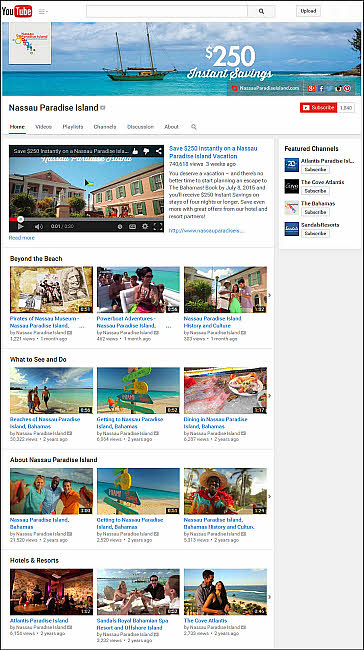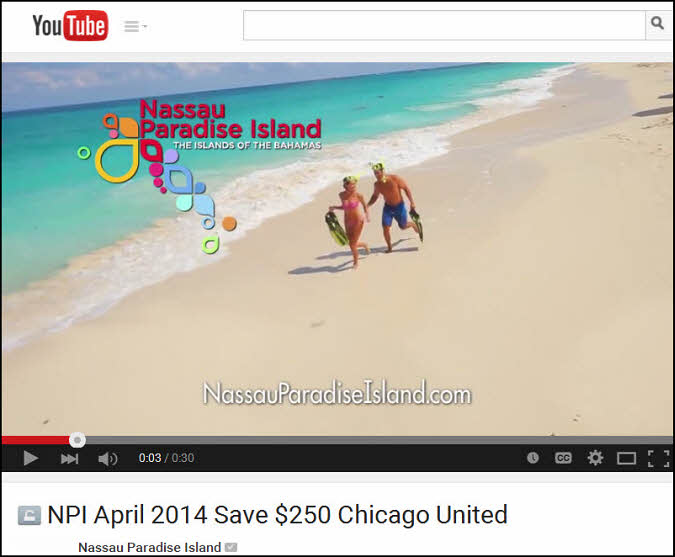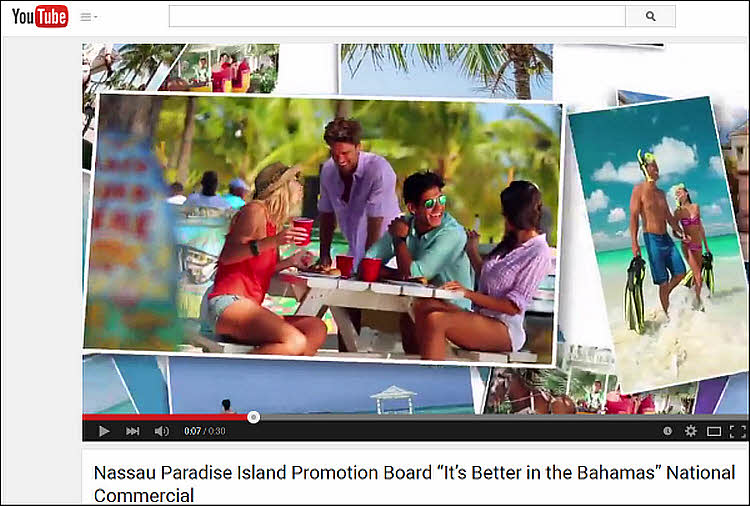by
Courtney Eckerle, Manager of Editorial Content
THE CUSTOMER
Nassau Paradise Island was trying to reach "a very targeted traveler," Kim Anderson, Vice President of Marketing, Nassau Paradise Island, said.
"This is a person who has been identified via Google as having an interest in destination-related travel information on Nassau, Atlantis, Paradise Island, Bahamas and the Caribbean," she said, adding that these travelers want to stay overnight and are not cruisers, who are day visitors.
"With the Bahamas being easily accessible from the East Coast, New York is the number one market; Florida is number two. Beyond there is Boston, Washington, D.C., Philadelphia, Atlanta, Chicago, Houston and Dallas. Los Angeles is consistently in the top 10 each month," Anderson said, adding that, while the United States represents 80% of visitation, international targets include Canada, the United Kingdom, Europe, Brazil and Latin America.
"Generally, we find our target consumer is between the ages of 25 and 54 with a household income of over $75,000," Anderson said.
CHALLENGE
The Nassau Paradise Island Promotion Board (NPIPB) serves as a private sector tourism board, funded through a levy collected from member hotels.
The primary focus is to generate awareness and interest in Nassau Paradise Island, Bahamas as a vacation destination. The board is responsible for driving conversions for member hotels via
www.nassauparadiseisland.com.
In early 2013, NPIPB became the leading Caribbean website destination with the highest number of unique visitors.
"Our goal is to continue this growth and find new ways to provide value to our member hotels," Anderson said.
During peak travel periods (which for NPIPB is during spring and summer breaks as well as holidays), the board wanted to reach a broad audience of travelers in many major cities throughout the country. Without a very large marketing budget, they decided to utilize YouTube advertising rather than national TV ads in order to efficiently reach a large number of travelers and provide targeted information.
CAMPAIGN
This campaign began in January 2014 and utilized TrueView, YouTube’s pre-roll video service.
"Our goal was to utilize mapping and location marketing to target U.S consumers to increase website visitation. We initially set a goal of increasing traffic by 15 percent and increasing website conversions by 20 percent, with conversions being defined as website traffic leads that are sent directly to NPIPB hotel members," Anderson said.
Step #1. Review industry standards for video

Click here to see the full version of this creative sample
Since the board planned to utilize
YouTube advertising, the first step in this effort was to do "extensive research of online and travel industry trends as it relates to video viewing and travel planning habits," Anderson said.
What that consisted of was looking at broad and travel industry-specific research from sites like Google and eMarketer, and from there looking at more specific demographic information.
"We then looked for data specific to the travel industry to understand when and how video is used in the vacation planning cycle, from early inspiration through to booking and travel. We also wanted to learn more about how trends might differ between demographics, consumer origin markets and travel group composition," she said.
They wanted to ensure that before planning any video shoots, they knew what would catch the audience and what had been done in the industry for video ads previously.
"Our digital marketing team also did a full review of the current website and Google Analytics data," she added. This step was taken to further understand what customers were searching for and what actions they were taking, so the video could speak directly to that.
Step #2. Customize messages
Prior to this campaign, NPIPB simply used an "offer" spot or a "generic" travel spot. Now, the board was looking for various ways the videos could be manipulated to target different types of customers, such as families, couples, travelers from a particular location and singles.
From there, Anderson said, "each video was digitized into 30-second video with customized messages for each market and consumer segment."
Anderson and her team began to develop plans for targeting the video spots by booking in peak travel windows and key markets.
During peak travel booking windows, airfare credit incentives were offered to drive customer interest to Nassau Paradise Island, Bahamas, she said, and "when airfare credit was not available, Net Conversion limited our video targeting to the top ten markets based on research."
To promote these offers, the team utilized national YouTube TrueView campaigns to maximize reach by targeting top cities and areas, such as:
- New York
- South Florida
- Chicago
- Philadelphia
- Boston
- Washington, D.C.
- Houston
- Atlanta
"While we utilized dozens of ads, they all had a consistent video ad feel. We updated the videos for each specific offer and sale during several key booking periods throughout the year. We further customized the videos for key airline partners within the specific markets," she said.

Click here to see the full version of this creative sample
An example is
the targeted video that was created for the city of Chicago, with an offer for saving $250 with United Airlines.

Click here to see the full version of this creative sample
For travel offers tied to a specific travel period, Anderson added, these were only marketed during a few key travel planning periods during the year. When a travel special was not being promoted, the team varied the budget accordingly and used general brand spots promoting the destination (for example,
"It's Better in the Bahamas") to keep brand awareness high.
Step #3. Optimize videos continuously
As the campaign progressed, the team would optimize each video based off of the performance metrics established alongside video completion rates. To accomplish that, the team was consistently monitoring the campaigns over time to ensure that they were focusing the efforts on the areas that worked best.
"While variability is normal, when we achieved performance was exceptionally good — for example, higher completion rate — we placed higher bids ... or added more budget to those campaigns. Meanwhile, lower performing campaigns were adjusted to receive lower bids," Anderson said.
"Using tools provided by [YouTube], we were able to continue watching users that saw the ad and determine if they later took actions that resulted in them coming to our website," she said.
Location marketing was an especially effective and efficient way to reach the target audience, Anderson said. The team tailored the campaigns to specific consumer segments and locations in order for the ad to be most effective.
The team broke up videos by geography, running customized versions in select metro areas and specific non-stop airline markets, including when a new air service was introduced to the market, Anderson said.
YouTube ads were effective for these digital video ads, especially from a budget standpoint because, "we only pay when someone chooses to watch our video, so it provides a strong ROI and allowed for flexibility within our budget," she said.
YouTube only requires you to pay for completed views, and the team was able to track and measure video skip rates and adjust the budget based on this data, to ensure the videos were targeted towards the right consumers.
RESULTS
The team not only achieved their original goal of increasing website traffic by 15%, but instead increased it by 20%.
In the first half of 2014, the team drove:
- A 19% increase in website traffic
- A 31% increase in conversions
This resulted in 555,500 actual conversions for Nassau Paradise Island Promotion Board, and Anderson added that "studies collected from Google also reported a brand awareness increase of 39% for our efforts in June 2014 alone."
With the videos, the team was able to:
- Engage targeted consumers with an average cost of $0.15 per completed video view
- An average video completion rate of 20% (up from 15% the previous year)
- An estimated 59 million impressions
- Over 14 million completed views
- Increase website visitation 30% from top origin markets
- Deliver 50% more leads to partner resorts
"Our biggest takeaway was the benefit of using video ads to be extremely targeted and measurable. It’s a great tool to allow you to customize and refine your message to smaller audiences. We can clearly see the impressions and click rates for each target audience that will inform our marketing strategy for the coming year," Anderson said.
Creative Samples
- NPIPB YouTube page
- Chicago United video
- "It’s Better in the Bahamas" video
Sources
Nassau Paradise Island Net Conversion (Nassau Paradise Island vendor)
Related Resources
Social Media Marketing: Travel company uses Facebook as a tool for generating testimonials Inbound Marketing: Pinterest-based strategy leads to 77% new site traffic Inbound Marketing: The top three tactics from MarketingSherpa case studies in 2014 Inbound Marketing: Small business builds YouTube channel from the ground up, expands to 40 countries












